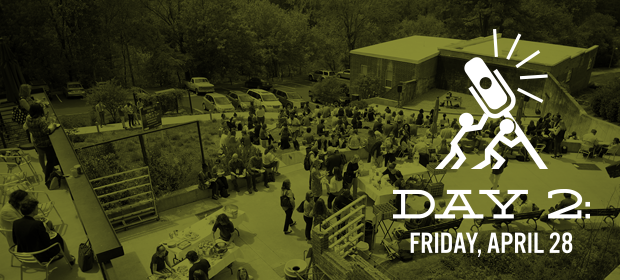Where We Work
See our interactive map



Be informed. Tell stories. Stick together. And other lessons on how to keep doing good from SwitchPoint 2017.
Psst. Did you miss day 1 of SwitchPoint? Here's a recap.
It feels good to get out, doesn’t it?
Not just out into the sunshine, though that’s nice too. But really out. Out of the office, out of the confines of our everyday tasks, out into a space where it’s easier to see just how our life’s work fits into and connects with the wider world.
“I call this space the blur,” said research scientist, rapper, and fashion designer David Moinina Sengeh during his keynote talk today at SwitchPoint 2017.
Imagine a Venn diagram of your life and interests—that spot where all the disparate circles intersect is the blur. For Sengeh, his research and design work on prosthetics is driven by the blur of medical imaging, soft tissue modeling, and functional computer-aided design.
“I’m from Sierra Leone,” he said. “Lots of amputees there. Lots of amputees everywhere.” And when we look at complex problems like this widespread need for new limbs, he said, “we know they’re complex, but we tend to say, ‘I want to just focus on one thing, one small part of the problem.’”
But that doesn’t really work. What about affordability? Transportation to and from fittings? Necessary ongoing care? Designing a comfortable prosthetic is only one part of the solution, Sengeh said.
Maybe that’s one of the nice things about the blur: You’re likely to run into people there who are working on those problems, who care about the same things you do. And who knows? Maybe you’ll team up and do some good together.
That’s what SwitchPoint is about.
Ideas and solutions are what we need in international development, especially right now.
Today was the second and final day of SwitchPoint 2017, a gathering of humanitarians from all over the world. While the conference is hosted by a global health organization (IntraHealth International), it’s designed to pull together smart, curious, creative people from all circles of humanitarian and global development work.
On stage this year were frontline health workers and policy wonks, executives and entrepreneurs, techies and teachers, marketers, academics, artists, and I’m not kidding, an actual magician (slash scientist).
All are doing their part, in their own corners of the world, for greater social good. And all headed to Saxapahaw, North Carolina, this year to find new, unexpected partners within the blur.
And hey, since we’re all here, why not bring kids into the conversation, too?
Liz Parrott Radzicki and Caroline Weeks of Participate are a former sixth-grade teacher and a marketer, respectively, who are doing just that by helping teachers build the Sustainable Development Goals into their curricula.
“What if schools prioritized global citizenship early?” they asked. “What if school was a place not just for preparation for the world, but to participate in the world?”
There are more than 50 million public school students in the United States, and more than three million full-time public school teachers. Imagine the potential impact of bringing up 50 million new global citizens in the US, 50 million kids who are health-conscious, water-wise, culturally and digitally literate.
Imagine the ideas and solutions to real-world problems they could eventually come up with if they start thinking about the issues as early as kindergarten.
Ideas and solutions are what we need in international development, particularly as potential changes in global aid loom larger this week. It’s not fun to talk about those issues, said Loyce Pace of the Global Health Council today, but we can’t ignore them. And the global development community has work to do if we’re going to convince lawmakers not to slash funding for humanitarian aid.
“All of the messages we’ve given in the past about the importance of global health are still true,” she said, “but we need to come up with different ways of talking about things to different people. People who want to know what’s in it for them, how much money will they make, how safe will they be?”
She offered three pieces of advice on how to do this:
Be informed.
Tell stories.
Stick together.
“We can’t think in terms of winners and losers in global health,” Pace said. “If we lose, then we are all losers. That’s our reality. But I don’t think all is lost. The truth is we’ve been here before. We all have our capes and tights tucked away. So put those on with me. Let’s make sure we all—together—don’t do the easy thing, but the thing that’s worth it."
Check out the full program for SwitchPoint 2017.
Get the latest updates from the blog and eNews




